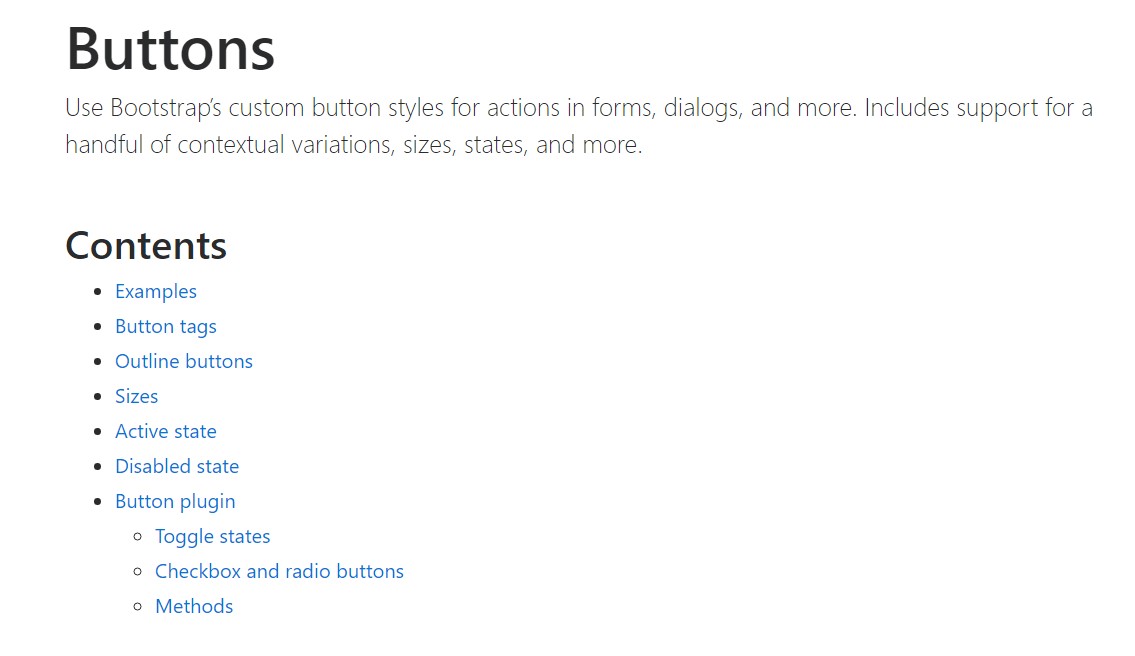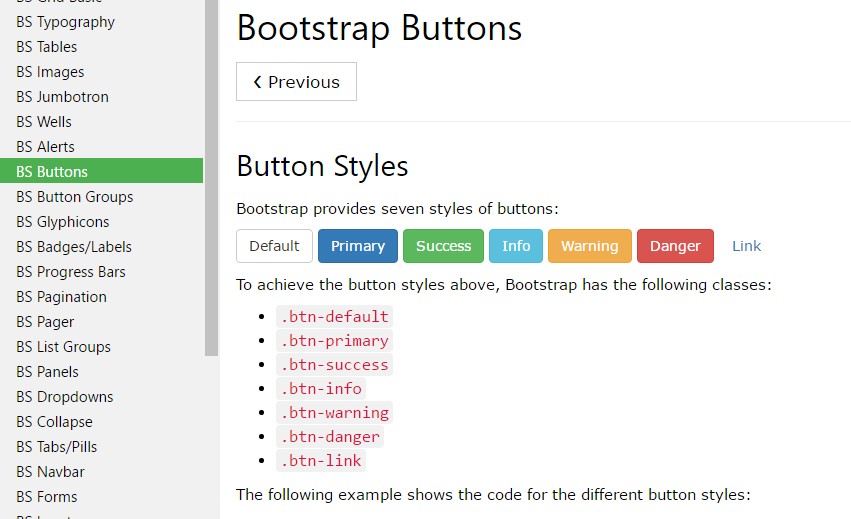Bootstrap Button Group
Introduction
The button components besides the urls wrapped within them are maybe one of the most important features helping the users to have interaction with the web pages and move and take various actions from one web page to one other. Specifically now in the mobile first community when about half of the web pages are being viewed from small-sized touch screen gadgets the large comfortable rectangle zones on screen simple to discover with your eyes and touch with your finger are more crucial than ever. That's exactly why the brand-new Bootstrap 4 framework advanced delivering extra comfortable experience giving up the extra small button size and providing some more free space around the button's subtitles to get them a lot more legible and easy to make use of. A small touch providing a lot to the friendlier appeals of the new Bootstrap Button Hover are additionally just a little more rounded corners that together with the more free space around helping make the buttons a lot more satisfying for the eye.
The semantic classes of Bootstrap Button How
Within this version that have the very same variety of simple and awesome to use semantic styles providing the opportunity to relay definition to the buttons we use with simply just incorporating a single class.
The semantic classes are the same in number as in the last version still, with several enhancements-- the hardly used default Bootstrap Button Twitter basically carrying no meaning has been dropped in order to get removed and replace by the even more crafty and user-friendly secondary button designing so right now the semantic classes are:
Primary .btn-primary - painted in soft blue;
Info .btn-info - a bit lighter and friendlier blue;
Success .btn-success the good old green;
Warning .btn-warning colored in orange;
Danger .btn-danger that comes to be red;
And Link .btn-link that comes to design the button as the default link component;
Just make sure you first incorporate the main .btn class just before using them.

<button type="button" class="btn btn-primary">Primary</button>
<button type="button" class="btn btn-secondary">Secondary</button>
<button type="button" class="btn btn-success">Success</button>
<button type="button" class="btn btn-info">Info</button>
<button type="button" class="btn btn-warning">Warning</button>
<button type="button" class="btn btn-danger">Danger</button>
<button type="button" class="btn btn-link">Link</button>Tags of the buttons
The .btn classes are built to be used with the <button> element. You can also use these classes on <a> or <input> elements (though some browsers may apply a just a bit different rendering). When ever using button classes on <a> elements which are used to cause in-page functions (like collapsing content), instead of linking to new webpages or areas within the existing web page, these links should be given a role="button" to appropriately convey their role to assistive technologies such as screen viewers.

<a class="btn btn-primary" href="#" role="button">Link</a>
<button class="btn btn-primary" type="submit">Button</button>
<input class="btn btn-primary" type="button" value="Input">
<input class="btn btn-primary" type="submit" value="Submit">
<input class="btn btn-primary" type="reset" value="Reset">These are however the fifty percent of the attainable appearances you can include in your buttons in Bootstrap 4 ever since the updated version of the framework also gives us a brand-new suggestive and pleasing way to design our buttons keeping the semantic we currently have-- the outline mode.
The outline mechanism
The solid background without border gets replaced by an outline using some text with the related coloring. Refining the classes is certainly very easy-- simply add in outline right before selecting the right semantics like:
Outlined Major button comes to be .btn-outline-primary
Outlined Second - .btn-outline-secondary and so on.
Necessary aspect to note here is there really is no such thing as outlined web link button in such manner the outlined buttons are in fact six, not seven .
Change the default modifier classes with the .btn-outline-* ones to remove all background pictures and colorings on any sort of button.

<button type="button" class="btn btn-outline-primary">Primary</button>
<button type="button" class="btn btn-outline-secondary">Secondary</button>
<button type="button" class="btn btn-outline-success">Success</button>
<button type="button" class="btn btn-outline-info">Info</button>
<button type="button" class="btn btn-outline-warning">Warning</button>
<button type="button" class="btn btn-outline-danger">Danger</button>More content
The semantic button classes and outlined appearances are really great it is important to remember some of the page's visitors won't actually be able to see them so if you do have some a bit more special meaning you would like to add to your buttons-- make sure along with the visual means you also add a few words describing this to the screen readers hiding them from the page with the . sr-only class so absolutely everybody might get the impression you want.
Buttons scale
As we told before the updated version of the framework angles for legibility and easiness so when it refers to button scales alongside the default button size which requires no extra class to get appointed we also have the large .btn-lg plus small .btn-sm proportions yet no extra small option since these are far too hard to target with your finger-- the .btn-xs from the earlier version has been dropped. Surely we still have the handy block level button element .btn-block spanning the whole width of the element it has been placed within which combined with the large size comes to be the perfect call to action when you need it.

<button type="button" class="btn btn-primary btn-lg">Large button</button>
<button type="button" class="btn btn-secondary btn-lg">Large button</button>
<button type="button" class="btn btn-primary btn-sm">Small button</button>
<button type="button" class="btn btn-secondary btn-sm">Small button</button>Create block level buttons-- those that span the full width of a parent-- by adding .btn-block.

<button type="button" class="btn btn-primary btn-lg btn-block">Block level button</button>
<button type="button" class="btn btn-secondary btn-lg btn-block">Block level button</button>Active mechanism
Buttons will appear pressed (with a darker background, darker border, and inset shadow) when active.

<a href="#" class="btn btn-primary btn-lg active" role="button" aria-pressed="true">Primary link</a>
<a href="#" class="btn btn-secondary btn-lg active" role="button" aria-pressed="true">Link</a>Disabled setting
Force buttons seem non-active through incorporating the disabled boolean attribute to any kind of <button> element.

<button type="button" class="btn btn-lg btn-primary" disabled>Primary button</button>
<button type="button" class="btn btn-secondary btn-lg" disabled>Button</button>Disabled buttons employing the <a> element behave a bit different:
- <a>-s do not support the disabled feature, in this degree you have to put in the .disabled class making it visually appear disabled.
- Some future-friendly styles are involved to disable all pointer-events on anchor buttons. In internet browsers that support that property, you will not notice the disabled arrow at all.
- Disabled buttons must include the aria-disabled="true" attribute to signify the condition of the component to assistive technologies.

<a href="#" class="btn btn-primary btn-lg disabled" role="button" aria-disabled="true">Primary link</a>
<a href="#" class="btn btn-secondary btn-lg disabled" role="button" aria-disabled="true">Link</a>Link functions caveat
The .disabled class uses pointer-events: none to try to disable the url capability of <a>-s, but that CSS property is not yet standardised. Plus, even in web browsers that do support pointer-events: none, computer keyboard navigating remains uninfluenced, showing that sighted key-board users and users of assistive systems will still have the chance to activate these urls. To be safe, add a tabindex="-1" attribute on these links (to prevent them from receiving keyboard focus) and use custom JavaScript to disable their functionality.
Toggle attribute

<button type="button" class="btn btn-primary" data-toggle="button" aria-pressed="false" autocomplete="off">
Single toggle
</button>More buttons: checkbox plus radio
Bootstrap's .button styles may possibly be applied to additional elements, for example, <label>- s, to produce checkbox or radio style button toggling. Add data-toggle=" buttons" to .btn-group consisting of those modified buttons to permit toggling in their various styles. The checked state for these buttons is only updated via click event on the button.
Note that pre-checked buttons need you to manually put in the .active class to the input's <label>.

<div class="btn-group" data-toggle="buttons">
<label class="btn btn-primary active">
<input type="checkbox" checked autocomplete="off"> Checkbox 1 (pre-checked)
</label>
<label class="btn btn-primary">
<input type="checkbox" autocomplete="off"> Checkbox 2
</label>
<label class="btn btn-primary">
<input type="checkbox" autocomplete="off"> Checkbox 3
</label>
</div>
<div class="btn-group" data-toggle="buttons">
<label class="btn btn-primary active">
<input type="radio" name="options" id="option1" autocomplete="off" checked> Radio 1 (preselected)
</label>
<label class="btn btn-primary">
<input type="radio" name="options" id="option2" autocomplete="off"> Radio 2
</label>
<label class="btn btn-primary">
<input type="radio" name="options" id="option3" autocomplete="off"> Radio 3
</label>
</div>Approaches
$().button('toggle') - toggles push state. Grants the button the visual appeal that it has been turned on.
Conclusions
Generally in the new version of the most popular mobile first framework the buttons evolved aiming to become more legible, more easy and friendly to use on smaller screen and much more powerful in expressive means with the brand new outlined appearance. Now all they need is to be placed in your next great page.
Examine a couple of video clip tutorials regarding Bootstrap buttons
Linked topics:
Bootstrap buttons: official documentation

W3schools:Bootstrap buttons tutorial

